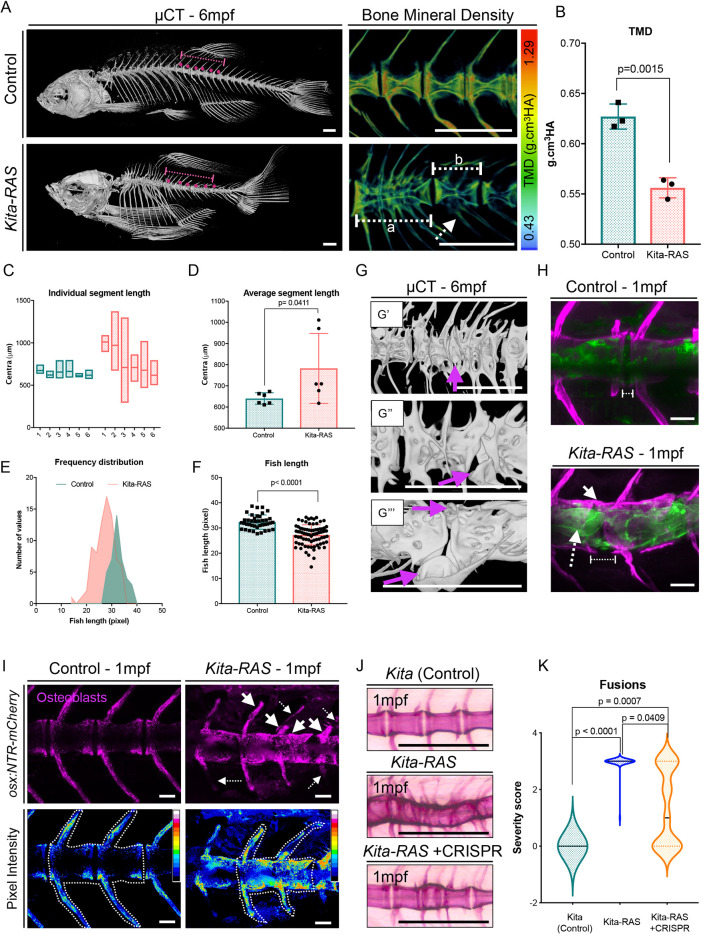Fig. 6. (A) ÁCT images of adult (6-month-old; 6?mpf) control (kita-mCherry) and kita-RAS. Note severe fusions and shortening of the fish length in kita-RAS. A zoomed region, colour coded for bone mineral density [tissue mineral density (TMD); in g/cm3 hydroxyapatite (HA)], is shown as an example. Note the decreased mineral density in kita-RAS. Fusions compromising two (white dashed line, b) to several vertebrae (white dashed line, a) are shown. The arches are also compromised (white dashed line arrow). Scale bars: 500?Ám. (B) TMD calculation. Unpaired two-tailed Student's t-test was used as a statistical test (two vertebrae per fish were analysed; control n=3 fish, kita-RAS n=3 fish). (C) Frequency distribution of the length of six consecutive segments, separated by a defined IVD space, were measured in Amira using 3D perspective measurement. The studied region is shown with a dashed line and magenta dots in A. kita-RAS show high variability in length of segments. (D) The average segment length was increased in kita-RAS. Six vertebrae per fish were analysed; control n=3 fish, kita-RAS n=3 fish. Unpaired, nonparametric t-test (Mann?Whitney test). (E) Frequency distribution of fish length in controls and kita-RAS measured in pixels, from X-ray images. (F) Fish lengths (measured in pixels) of controls (n=40) and kita-RAS (n=78). Unpaired, nonparametric t-test (Mann?Whitney test). (G) Higher-resolution ÁCT images to show abnormalities in detail. G?, fusions of several vertebrae and hemicentra (arrow). G?, lateral view of a hemicentra (arrow). G?, ventral view of a hemicentra (arrows). Scale bars: 500?Ám. (H) One-month-old (1?mpf) control (kita-mCherry) and kita:RAS-GFP stained with Calcein Green and Alizarin Red S, respectively, to label the bone (magenta). In kita-RAS, a hyperplastic notochord cell is indicated with a white dashed line arrow, mineralised IVD is indicated with a white arrow, and a region of incomplete mineralisation and future cleft is marked with a dashed line. Note that notochordal cells fail to organise in IVD domains. Scale bars: 50?Ám. (I) 1?mpf control and kita:RAS-GFP showing osteoblasts [Tg(osx:NTR-mCherry)]. Arrows indicate regions of increased osteoblasts; dashed line arrows show regions lacking osteoblasts and abnormal growth of arches. Pictures were processed to show pixel intensity (blue=low intensity), to visualise where osteoblasts are highly expressed. Two vertebrae in each fish were selected for quantification of mean pixel intensity. (J) Alizarin Red S staining of 1?mpf kita, kita-RAS and kita-RAS+CRISPR. Note an intermediate (less severe) phenotype in kita-RAS+CRISPR, suggesting rescue of bone phenotype. (K) Violin plot to show the distribution of vertebral column severity scores, from 0 (less severe) to 3 (most severe), in kita (n=47), kita-RAS (n=44) and kita-RAS+CRISPR (n=83). One-way ANOVA and Tukey's multiple comparisons test were used; P-values are indicated when significant. Scale bars: 50?Ám.
Image
Figure Caption
Figure Data
Acknowledgments
This image is the copyrighted work of the attributed author or publisher, and
ZFIN has permission only to display this image to its users.
Additional permissions should be obtained from the applicable author or publisher of the image.
Full text @ Dis. Model. Mech.

